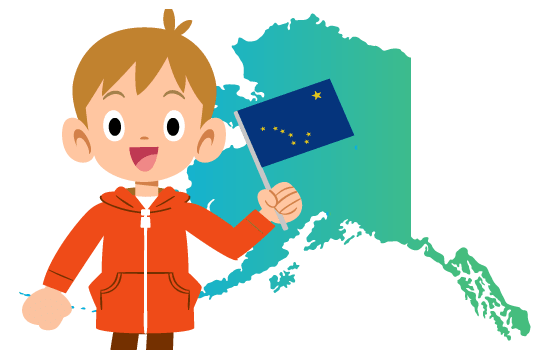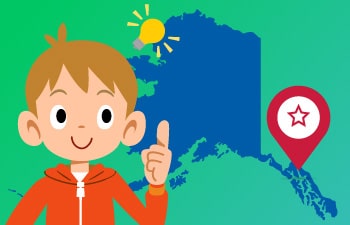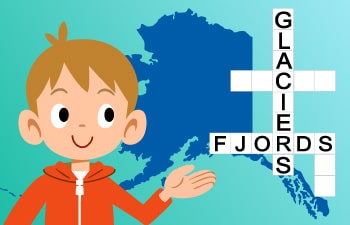What is the highest mountain peak in North America? That would be Alaska’s Mt. McKinley, also known as “Denali” or “The Great/High One” in the Native Athabascan language! Alaska is one of only two states (can you guess the other one?) that is not bordered by any other US state, and it is the perfect place to see the aurora borealis, or northern lights. One of the most interesting unique qualities about Alaska is that for two months in the summer, the sun doesn’t set at all in the northern part of the state!
Learn more interesting facts about Alaska, including historical facts about Alaska, an Alaska history timeline, geography facts and more, by reading this article. Time4Learning members can download our list of PreK-12 interactive activities that align with a study of Alaska. Below are a few Alaska facts for kids:
Alaska Fast Facts
|
Became a State: |
January 3, 1959 |
|---|---|
|
Order it Joined the Union: |
49th state |
|
State Capital: |
Juneau |
|
State Abbreviation: |
AK |
|
Border States: |
|
|
State Flag: |
|
|
State Song: |
|
|
State Flower: |
Alpine Forget-Me-Not |
|
State Nickname: |
|
|
Notable Alaskans: |
|
Historical Facts about Alaska
Alaska’s history begins as early as 10,000 BC, when Alaska’s early people either sailed from Russia or walked over what used to be the Bering Land Bridge (a 600-mile-wide stretch of land that has since been covered with water). Native people still living in Alaska include the Aleuts, Athabascans, Inuit, Haida, Tlingit, and Yup’ik. First discovered by Vitus Bering in 1741, Alaska was settled by Russians in 1784. In 1867, the US purchased Alaska from Russia for just two cents an acre.
Although some people thought the US got a bad deal, calling the purchase “Seward’s Folly” (after the US Secretary of State who negotiated the treaty), the discovery of gold in Alaska in 1872 proved them wrong. With the construction of the Alaska Railroad and the start of copper mining, the 1920s and 1930s brought more settlers. Alaska was added to the United States as the 49th state in 1959, and its population continued to grow with the development of the Prudhoe Bay oil fields (now responsible for three-fourths of the state’s income) until about the 1990s when the population stabilized.
Controversy over Alaska’s natural resources has been significant throughout the state’s history. Major conflicts occurred in the 1960s and 1970s between petroleum companies and conservationists over the Trans-Alaska pipeline, which runs north to south carrying oil across Alaska. Once again in the 1980s, conflict occurred over whether to allow permanent drilling in the Arctic National Wildlife Refuge and intensified with the oil spill of the Exxon Valdez in 1989. Further conflict arose in the early 2000’s surrounding whether to drill in the 23-million-acre National Petroleum Reserve in Alaska and increased again in 2004 with an oil spill in the Aleutian Islands. Recently, dams have been built to begin harnessing Alaska’s tremendous potential for hydropower, continuing the state’s status as a center of debate regarding the balance between development and conservation.
Take a look at the Alaska history timeline below to learn important historical facts about Alaska:
1728
Vitus Bering led an expedition, sent by Tsar Peter I of Russia, that failed to discover North America due to fog1741
Vitus Bering discovered Alaska1784
Russia settled Alaska at Three Saints Bay, near Kodiak, which became Alaska’s capital1804
Battle of Sitka, only major armed conflict between Europeans and Native Alaskans1806
Russian-American Company (organized by a 1799 charter from Emperor Paul I of Russia) moved its headquarters to Sitka, moving Alaska’s capital from Kodiak to Sitka1824
Russia made treaties with US and Great Britain establishing trade boundaries and commercial regulations1867
Treaty of Cession, which transferred Alaska to the US from Russia1872
Gold was discovered in Alaska1877
Military governing of Alaska ended1906
- Capital was moved to Juneau because of its importance due to the gold rush
- First Alaskan representative to Congress was elected
1912
- Congress established the Territory of Alaska with an elected legislature
- Novarupta Volcano erupted, one of the most violent volcanic eruptions in the world
1938
Copper mine at Kennecott closed, ending a major industry in Alaska1942
Japan invaded the Aleutian Islands during World War II1959
Alaska became the 49th state in the US, increasing the size of the US about one-fifth1961
Kenai oil field was developed1964
Alaska Earthquake of 1964, North America’s strongest earthquake thus far1967
First Iditarod Trail Sled Dog Race1968
North Slope oil fields were discovered, leading to the Trans-Alaska Pipeline1971
Alaska Native Claims Act, which met land claims made by Native Alaskans1989
Exxon Valdez oil spill, releasing 250,000 barrels of oil into Prince William Sound2004
Oil spill in the Aleutian Islands, releasing 350,000 gallons of oil into the oceanBring history and geography to life with Time4Learning’s interactive online social studies curriculum for grades 2-12.
Alaska Geography Facts
Now that you’ve learned some interesting facts about Alaska’s history, let’s gather some more facts and information about Alaska’s geography. “Alaska” is derived from the Aleut word that means “great land.” Geographically, Alaska is known for its glaciers and fjords, mountains, and waterways. It has the highest peak, Mt. McKinley, in North America. Actually, 17 of the 20 highest peaks in America are in Alaska. There are more than 3,000 rivers; 3,000,000 lakes; and 100,000 glaciers. In fact, Alaska has more ice fields and glaciers than the rest of the world combined. Alaska has about 5,000 earthquakes per year and has survived three of the ten strongest earthquakes in the world. With numerous potentially active volcanoes, Alaska has also experienced the most violent eruption of the century in 1912 when Novarupta Volcano erupted. Alaska is cold with most of its land covered in a layer of permanently frozen soil called permafrost. In fact, Alaska has the record for the coldest temperature ever in the US, -80 degrees Fahrenheit in 1971!
Alaska has a variety of geographic regions. The northern and western coasts are tundra, flat lands without trees, and have very cold winds. The center of the state includes plains and lowlands, as well as the taiga forest with its evergreen trees, meadows, and lakes. Rainforests cover the southeastern coast. Alaska’s trees consist of cedars, hemlocks, pines, and Sitka spruce (state tree). Did you know that the state’s flower, the forget-me-not, only provides a scent at night?
Alaska is famous for its large mammals, including moose, caribou, polar bears and Kodiak bears, bison, Dall sheep, and musk oxen. The ocean and waterways bring beluga whales, walruses, salmon, and other marine life. Birds include the albatross, the loon, and the eagle. Unfortunately, global warming since the late 1970s threatens Alaska’s wildlife as the permafrost melts, the ice decreases in thickness, and the pack ice recedes farther north.
Start getting familiar with the state by checking out this map of Alaska. Then read through the following Alaska geography facts. Print out the map of Alaska provided below and add these items to the map.
- Alaska is bordered by the Beaufort Sea and the Arctic Ocean in the north; the Gulf of Alaska and the Pacific Ocean in the south; Russia, the Bering Sea, Bering Strait, and Chukchi Sea in the west; and the Canadian provinces of Yukon Territory and British Columbia in the east.
- The capital, Juneau, lies close to the border with the Canadian province of British Columbia in the southeastern part of the state.
- The Yukon River cuts across the state diagonally from British Columbia to the Bering Sea.
- Lake Iliamna, Alaska’s largest lake (1,000 square miles), is in the southwestern part of the state.
- The panhandle region, a strip of land 25 to 50 miles wide in the southeasternmost corner of the state, includes coastal mountains known as the Boundary Ranges.
- The Boundary Ranges extend westward to the Chugach Range at the northernmost edge of the Gulf of Alaska.
- Across the southern third of mainland Alaska lies the Alaska Range, which connects to the Aleutian Range and then the Wrangell Mountains moving eastward.
- The Aleutian Islands consist of 14 larger islands and 55 smaller islands that separate the Bering Sea from the North Pacific.
- Just north of the center of Alaska lies the west-east running Brooks Range.
- North of the Brooks Range is called the North Slope, a truly polar environment that is a significant source of oil.
- The Alexander Archipelago includes 1,100 islands in the panhandle region.
- Kodiak Island is located just southeast of the Alaska Peninsula.
- Alaska’s highest point (and also the highest peak in North America) is Mt. McKinley, at 20,320 feet above sea level, located north of Anchorage in the south-central region of Alaska.
- The lowest point is at sea level where the state meets the Pacific Ocean, Bering Sea, and Arctic Ocean.
Alaska State Map
Download our FREE Alaska state map printable. Use it as a coloring page or use it to plot the state’s geographical features.
Activities for Children in Alaska
Want to go beyond just reading fun facts about Alaska? See the unique places of “The Last Frontier” by visiting the state. Homeschoolers in Alaska don’t have far to go, but taking a trip to Alaska might be worthwhile for those out of state, too. Here are a few ideas to help you learn more interesting facts about Alaska:
- Alaska State Museum (Juneau): See the more than 32,000 objects including works of art, natural history specimens, historic artifacts, and Native Alaskan objects. Almost half of the collection is Alaska Native material showcasing daily life and ceremonial pieces from all major cultural groups. The website also contains online resources for teachers that can be used in your homeschool.
- Denali National Park and Preserve (Denali Park): Explore Alaska’s most popular tourist destination that is the location of Mt. McKinley (“Denali”), the highest peak in North America. Drive along the one road that crosses the park’s six million acres to see taiga forest transform into alpine tundra and snowy mountains. Year-round activities include hiking, camping, biking, photography, birding, or flightseeing. Try to spot moose, caribou, wolves, Dall sheep, or grizzly or black bears. Meet the park’s sled dogs or attend a mushing demonstration. The park participates in the 4th grade Every Kid Outdoors voucher program and provides a free online “Denali with Kids” Family Fun Travel Guide. Check the website for fee-free days.
- Dog Sled Rides (Various Locations): Alaska is known for its Iditarod, an annual 1,000-mile sled dog race that occurs in early March and runs from Anchorage to Nome. Schedule your visit around the race, if you can. Whenever you visit Alaska, plan a ride to experience glacier dog sledding firsthand. Visit the Iditarod Headquarters to see the sled dogs (and their puppies), trophies, displays, and photos. Be sure to access the educational resources even if you can’t make the trip.
- Mendenhall Glacier (Juneau): Find out about plant succession by viewing pioneer vegetation that forms over loose sand and leads to larger plants. See the Mendenhall glacier, and hike one of the many trails. Check the schedule for fee-free days and enjoy the free online Just for Kids activities about wildflowers.
- Sheldon Museum and Cultural Center (Haines): Learn about the history and heritage of the Native Alaskans of southeastern Alaska. The museum has exhibits showing over 4,000 artifacts, more than 12,000 photographs and images, and over 2,000 books. Explore the numerous ledgers, journals, letters, ship logs, journals, and maps. Guided tours are available by appointment.
Looking for more things to do with your kids in Alaska? Check out this post full of field trip ideas in Alaska!
Alaska Freebies and Deals for Homeschoolers
Want to learn more Alaska facts and information without spending a lot of money? Some of Alaska’s greatest treasures are accessible at free/reduced rates. Below are just a few ideas:
- Glacier Bay National Park (Gustavus): Experience the coastlines, fjords, rainforest, glaciers, and mountains of this 3.3 million-acre park. Visit by cruise ship or get closer views by hiking, kayaking, rafting, or camping. Hunting and fishing are also allowed. See the Huna Tribal House or take a tour of the park via seaplane (for a cost). Check out the free visitor guide, videos, and curriculum materials or get together with a group of families and organize a free distance learning class. Best of all, there is never an entrance fee to the park, camping fees, or private boating fees!
- Katmai National Park and Preserve (King Salmon): Visit the Valley of Ten Thousand Smokes, an area of active volcanoes that was the site of one of the world’s most violent eruptions in 1912 at Novarupta. See the land that captures 9,000 years of human history and is an important habitat for salmon and brown bears. In addition to bear watching, try hiking, boating, camping, fishing, or flightseeing. Check the Park Fun link for activities for kids. There are no admission fees to the park.
- Kenai Fjords National Park (Seward): Visit the Harding Icefield and the nearly 40 glaciers that flow from it. See the wildlife that thrives in the icy waters and lush forests. Witness the unfortunate effects of climate change. Try hiking, kayaking, flightseeing, skiing, snowmobiling, snowshoeing and more. Resources for kids are available online as well as curriculum materials. Backpacks filled with art supplies can be checked out for free at the Nature Center during the summer months, and there are no admission fees or camping fees.
- Museum of the North (Fairbanks): Learn about Alaska’s art, culture, history, and science through its exhibits or hands-on crafts, investigations, and games. Explore a permanent exhibit on the northern lights or catch a movie about Alaska’s extreme weather. Local homeschoolers can borrow Homeschool Kits with the purchase of a Kit Pass. Check the website for the next Family Day when guests 14 and under are free or scheduled Homeschool Days when homeschool families receive free admission.
- Sitka National Historic Park (Sitka): See the large totem pole collection honoring the stand of the Tlingit people against Russian settlers and visit the restored Russian Bishop’s House. Walk the island’s scenic coastal trail. Have the kids get involved in the free Junior Ranger Program or borrow a free Discovery Pack from the visitor center for use in exploring the beach and intertidal zone. Those who can’t visit the park can access the Totem Trail Virtual Tour. Both the park visitor center and the Russian Bishop’s House have free admission.
Alaska Learning Games for Children
How many interesting things about Alaska do you know? Test your student’s knowledge of Alaska with these free games and activities:














I did not know that 17 of the 20 highest peaks in America are in Alaska. My son always asks me about going to Alaska because he watches the shows on TV and he loves snow and cold weather. It would be nice to learn more about Alaska history so that when we have a chance to visit, we can be more familiar which such as interesting country. https://jzonayreitz.com/product/jzonay-reitz-3/
Thanks for stopping by, Derek! We hope that when you finally get to visit Alaska, you have an amazing trip! 🙂